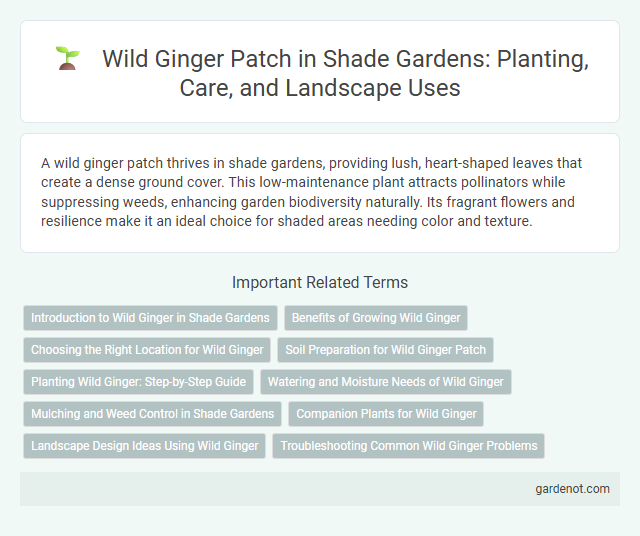A wild ginger patch thrives in shade gardens, providing lush, heart-shaped leaves that create a dense ground cover. This low-maintenance plant attracts pollinators while suppressing weeds, enhancing garden biodiversity naturally. Its fragrant flowers and resilience make it an ideal choice for shaded areas needing color and texture.
Introduction to Wild Ginger in Shade Gardens
Wild ginger (Asarum canadense) thrives in shade gardens, offering lush, heart-shaped leaves and unique, low-growing coverage that enriches woodland landscapes. This native perennial prefers moist, well-drained soil and creates a natural ground cover that suppresses weeds while attracting beneficial insects. Its subtle, bell-shaped flowers bloom close to the soil, adding delicate interest without overpowering other shade-loving plants.
Benefits of Growing Wild Ginger
Wild ginger (Asarum canadense) thrives in shade gardens, offering excellent ground cover that suppresses weeds and retains soil moisture. Its dense foliage provides habitat for beneficial insects and contributes to soil health through natural leaf litter decomposition. Growing wild ginger enhances biodiversity and adds unique aromatic and aesthetic value to shaded landscapes.
Choosing the Right Location for Wild Ginger
Selecting an ideal location for wild ginger involves identifying shaded or partially shaded areas with rich, well-draining soil to mimic its natural woodland habitat. The site should have consistent moisture without waterlogging, as wild ginger thrives in moist, humus-rich environments. Positioning the patch near trees or shrubs can provide natural protection and support healthy growth of this low-maintenance groundcover.
Soil Preparation for Wild Ginger Patch
Wild ginger thrives in rich, well-draining soil with high organic matter to mimic its native woodland environment. Incorporate plenty of leaf mold, aged compost, and well-rotted manure to improve soil fertility and moisture retention. Maintaining slightly acidic to neutral pH levels, around 5.5 to 7.0, supports optimal root development and growth in a shade garden setting.
Planting Wild Ginger: Step-by-Step Guide
Planting wild ginger (Asarum canadense) begins with selecting a shaded or partially shaded location with rich, well-draining soil high in organic matter. Prepare the site by loosening soil and incorporating compost to retain moisture and provide nutrients. Space rhizomes 12 to 18 inches apart, planting them just below the surface, then water thoroughly to establish strong root growth essential for healthy ground cover in a shade garden.
Watering and Moisture Needs of Wild Ginger
Wild ginger thrives in consistently moist, well-drained soil, making regular watering essential, especially during dry spells. It prefers shaded or partially shaded areas where moisture retention is naturally higher, reducing the frequency of watering. Maintaining adequate soil moisture supports healthy root growth and vibrant foliage in wild ginger patches.
Mulching and Weed Control in Shade Gardens
Mulching in wild ginger patches is essential for moisture retention and temperature regulation in shade gardens, helping create the ideal microenvironment for growth. Organic mulch like shredded leaves or bark suppresses weeds effectively by blocking sunlight and reducing soil disturbance. Regular mulching combined with careful hand-weeding minimizes competition from invasive species, promoting a dense, healthy wild ginger groundcover.
Companion Plants for Wild Ginger
Wild ginger thrives in moist, shaded environments and pairs well with perennial companions like hostas, ferns, and astilbes that share similar light and moisture requirements. These companion plants enhance the wild ginger patch by adding varied textures and colors, while also supporting ecosystem diversity in shade gardens. Integrating woodland phlox or trilliums can further complement wild ginger's groundcover, creating a lush and resilient shade garden habitat.
Landscape Design Ideas Using Wild Ginger
Wild ginger patches create lush, low-maintenance ground cover in shade gardens, thriving under trees and shrubs with their heart-shaped leaves and fragrant flowers. Incorporate wild ginger in landscape design to add texture and natural biodiversity, enhancing woodland aesthetics while suppressing weeds and retaining soil moisture. Pair wild ginger with ferns, hostas, and astilbes to achieve a layered, verdant understory that complements shaded environments.
Troubleshooting Common Wild Ginger Problems
Wild ginger patches can suffer from yellowing leaves due to overwatering and poor drainage, causing root rot and fungal infections. Pests such as slugs and vine weevils often damage leaves, requiring prompt identification and treatment with organic pest control methods. Ensuring well-drained soil and adequate shade helps prevent growth issues and promotes a healthy wild ginger patch.
Wild ginger patch Infographic

 gardenot.com
gardenot.com